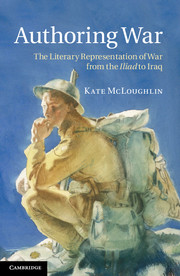Conclusion: To perpetual peace
Published online by Cambridge University Press: 01 June 2011
Summary
But this too is true: stories can save us.
Tim O'Brien, The Things They CarriedThis book has set out some of the principal challenges involved in representing war and explored how writers have responded to them: with difficulty and with success, with a range of formal devices, exploiting linguistic and literary resources to their maxima. It has argued that the necessary task of conveying conflict is accomplished by such means as enhancing credibility through the tropes of singularity and autopsy; using the Vietnam Wall approach (taliation nominatim) and the Unknown Warrior approach (synecdoche) to frame the scale of conflict for human comprehension; deploying the techniques of pastoral to communicate the peculiar psycho-physiologico-physical experience that is the war zone; maintaining superpositions to convey the synchronous, open-ended temporality of wartime; mobilising diversionary tactics to set in motion the functioning of the sublime; and invoking and depicting laughter to recreate the sense that the turbulent flow of war is often inimical and incomprehensible to the individual caught up within it. The ability to cause and represent (mirthless) laughter, in particular, has been characterised as one of war writing's great achievements: a phenomenon beyond both words and silence; the product of reason (at least, reason's decision to concede defeat) but felt in the body; subversive but un-interpretable; shocking and imperative. By this means and others, the challenges, to a great extent, have been met.
- Type
- Chapter
- Information
- Authoring WarThe Literary Representation of War from the Iliad to Iraq, pp. 189 - 194Publisher: Cambridge University PressPrint publication year: 2011



